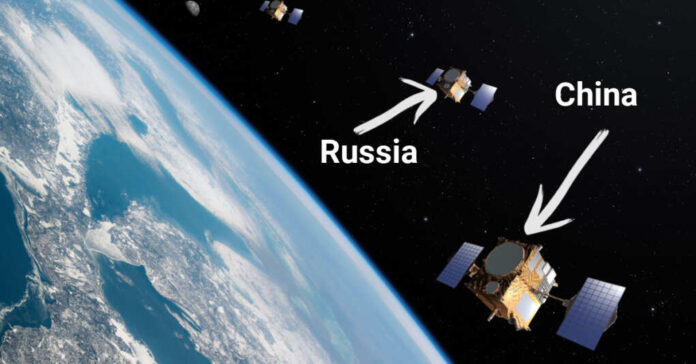
In a startling revelation, a recent report from the U.S. military sheds light on China and Russia’s covert efforts to populate space with dual-use satellites, concealing their true military capabilities. Titled “Competing in Space,” the report, jointly created by the National Space Intelligence Center and the National Air and Space Intelligence Center, unveils a growing menace that poses a direct threat to U.S. military and information superiority.
According to the report, China and Russia strategically view the United States as excessively reliant on space. To gain asymmetric advantages in potential conflicts, these nations are actively designing, testing, and demonstrating counter-space weapons to deny, disrupt, or even destroy satellites and space services. What’s more concerning is their penchant for masking or concealing these activities to evade international condemnation.
The dual-use nature of certain spacecraft technologies presents a challenge, making counterspace tests or hostile activities difficult to detect, attribute, or mitigate. The report highlights the example of a spacecraft equipped with sensors and robotic arms, initially designed for peaceful missions but with the potential for targeting or attacking other satellites.
One alarming instance mentioned in the report is China’s Shijian-21 satellite, which, in January 2022, towed a defunct Chinese navigation satellite to a graveyard orbit. Additionally, Shijian-17, armed with a colossal robotic arm, raises concerns about the possibility of a future system designed to grapple with other satellites.
Conversely, Russia has deployed prototype orbital anti-satellites in low Earth orbit (LEO), such as Cosmos 2504, 2519, and 2536, showcasing their testing of “kinetic kill capabilities.” Most satellites that orbit Earth are situated in LEO, about 1,200 miles from the surface, making this region a battleground for potential conflicts.
Chinese military exercises routinely incorporate jammers targeting satellite communications, indicating their interest in disrupting various satellite communications crucial for government and military operations. The report also highlights China’s pursuit of directed-energy weapons, including ground-based laser systems that could blind or damage satellite sensors.
Disturbingly, the report warns that by the mid-to-late 2020s, China could possess higher-power laser systems capable of causing significant satellite damage. China’s hypersonic weapon system, tested in 2021, raises concerns about the potential hindrance of reliable missile warnings and complicating defense engagements.
The report emphasizes the exponential increase in satellites since December 2018, with the total number reaching 7,096 by the end of 2022. The United States leads with 4,723 satellites, while China and Russia follow with 647 and 199, respectively. This surge in satellites, coupled with the rising international stature of China as a space power, underscores the escalating competition in space.
Beyond immediate Earth orbits, the report reveals a broader competition involving asteroids, the moon, Mars, and other celestial bodies. China’s ambitious goal to land astronauts on the moon by 2030 and collaborative projects like the International Lunar Research Station involving nations like Venezuela, Pakistan, South Africa, and Belarus accentuate the geopolitical significance of outer space.
The report highlights activities at Lagrange Points, where China’s Queqiao relay satellite is strategically positioned. These points, acting as strategic gateways, allow spacecraft to remain in deep space for extended periods, offering advantages for surveillance, space environment monitoring, and data relay.
Despite the escalating tensions and potential threats, the report underscores the lack of international consensus on space norms since the 1970s. China and Russia’s endorsement of a draft treaty fails to address the need to address various anti-satellite weapons and needs meaningful verification mechanisms.
In contrast, the U.S.-led Artemis Accords, signed by 33 nations as of December 2023, strive to establish a shared vision of peaceful, sustainable, and transparent cooperation in space. The report concludes with a stark warning, highlighting the expanding utility of space systems and the world’s vulnerability to dangers in the space environment. It cautions that those challenging international order will have access to systems capable of devastating and lasting impacts on progress both on Earth and in space.
The stakes are high, and the U.S. must remain vigilant in preserving its space access amid the escalating space race and hidden threats from China and Russia.














